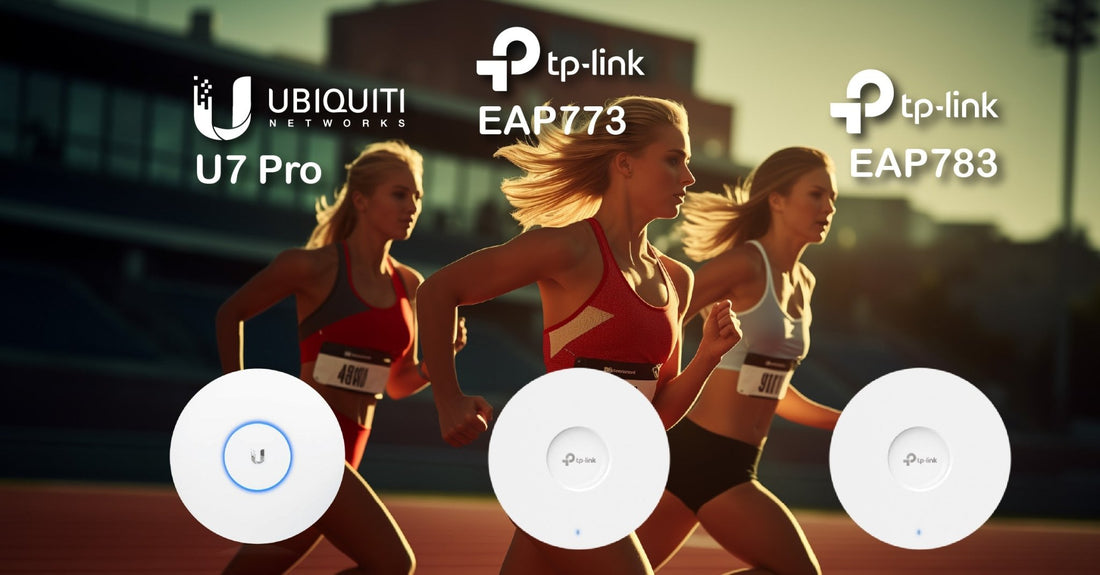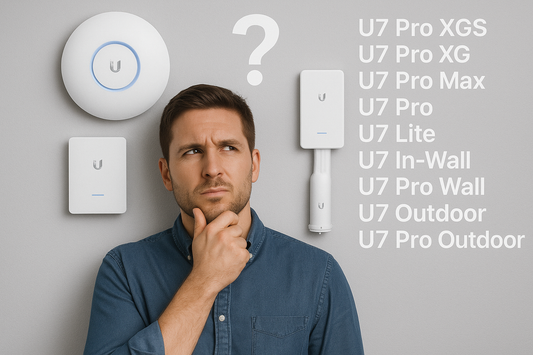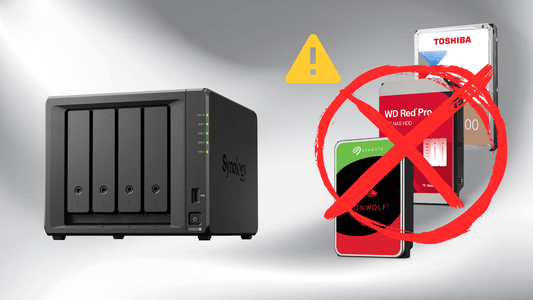Wi-Fi 7 Showdown: Ubiquiti U7 Pro vs TP-Link EAP773 vs EAP783 Detailed Comparison

The Future is Now: Navigating the War of Wi-Fi 7 - Ubiquiti U7 Pro vs TP-Link EAP773 vs TP-Link EAP783
In the ever-evolving world of wireless technology, Wi-Fi 7 is the new frontier, promising faster speeds, more reliable connections, and the power to handle an ever-growing number of devices. As businesses and tech enthusiasts gear up for this revolution, choosing the right access point becomes crucial. This comprehensive blog dives deep into the world of Wi-Fi 7, comparing three leading devices: Ubiquiti U7 Pro, TP-Link EAP773, and TP-Link EAP783.
Highlights
- Ubiquiti U7 Pro is known for its balanced performance across different frequencies.
- TP-Link EAP773 offers impressive 5 GHz performance.
- TP-Link EAP783 stands out with the highest total signal rate.
Key Features
Ubiquiti U7 Pro
- Speeds: 688 Mbps (2.4 GHz), 2882 Mbps (5 GHz), 5765 Mbps (6 GHz)
- Total Signal: 9335 Mbps
- Wireless Client Capacity: 300
TP-Link EAP773
- Speeds: 574 Mbps (2.4 GHz), 4320 Mbps (5 GHz), 5760 Mbps (6 GHz)
- Total Signal: 10654 Mbps
- Wireless Client Capacity: 500+
TP-Link EAP783
- Speeds: 1376 Mbps (2.4 GHz), 8640 Mbps (5 GHz), 11520 Mbps (6 GHz)
- Total Signal: 21536 Mbps
- Wireless Client Capacity: 640+
Comparison Table
| Feature | Ubiquiti U7 Pro | TP-Link EAP773 | TP-Link EAP783 |
|---|---|---|---|
| Speed Code | BE9300 | BE11000 | BE22000 |
| 2.4 GHz Speed | 688 Mbps | 574 Mbps | 1376 Mbps |
| 5 GHz Speed | 2882 Mbps | 4320 Mbps | 8640 Mbps |
| 6 GHz Speed | 5765 Mbps | 5760 Mbps | 11520 Mbps |
| Total Signal Rate | 9335 Mbps | 10654 Mbps | 21536 Mbps |
| Wireless Client Capacity | 300 | 384 | 768 |
| Max. Transmit Power (2.4/5/6 GHz) | 22/26/23 dBm | 25/25/23 dBm | 28/28/28 dBm |
| Ethernet Ports | 1 x 2.5 Gigabit | 1 x 10 Gigabit | 2 x 10 Gigabit |
| Antenna Gain (2.4/5/6 GHz) | 4.0/6.0/5.8 dBi | 4.0/5.0/5.0 dBi | 4.0/5.5/5.0 dBi |
| Bluetooth Antenna Gain | NIL | 4.0 dBi (Bluetooth 5.2) | 5.0 dBi (Bluetooth 5.2) |
| MIMO Configuration | 2×2 (All Bands) | 2×2 (All Bands) | 4×4 (All Bands) |
| Power Consumption | 802.3bt PoE+ or Non-Smart 21W | 802.3bt PoE++ or 12V/2.5A DC, Smart 26W | 802.3bt PoE++ or 12V/4.5A DC, Smart 34W |
| Warranty | 1 Year (Return to Factory) | 5 Years (1 to 1 exchange) | 5 Years (1 to 1 exchange) |
| Multiple SSIDs Supported | 24 | 24 | 24 |
Detailed Overview
-
Ubiquiti U7 Pro stands out for its significant performance in the 6 GHz band, with a total signal rate of 9335 Mbps. It's suitable for medium-sized environments where balanced performance is needed.
-
TP-Link EAP773 strikes a balance between high performance and affordability. With a total signal rate of 10654 Mbps and the ability to support more than 500 clients, it's ideal for high-traffic environments like cafes or small offices.
-
TP-Link EAP783 is the powerhouse among the three, boasting the highest total signal rate at 21536 Mbps and supporting over 640 clients. This makes it well-suited for large enterprises or tech-heavy environments.
Each device offers unique advantages, making the choice dependent on specific requirements like client capacity, total signal rate, and the physical environment where the device will be deployed.
In the "War of WiFi 7," choosing the right access point depends on specific needs. The Ubiquiti U7 Pro is a solid choice for environments that require balanced performance across different frequencies. The TP-Link EAP773 is ideal for users seeking enhanced 5 GHz performance. For those needing the highest total signal rate and capacity, the TP-Link EAP783 emerges as the clear winner.
No comments







0 comments